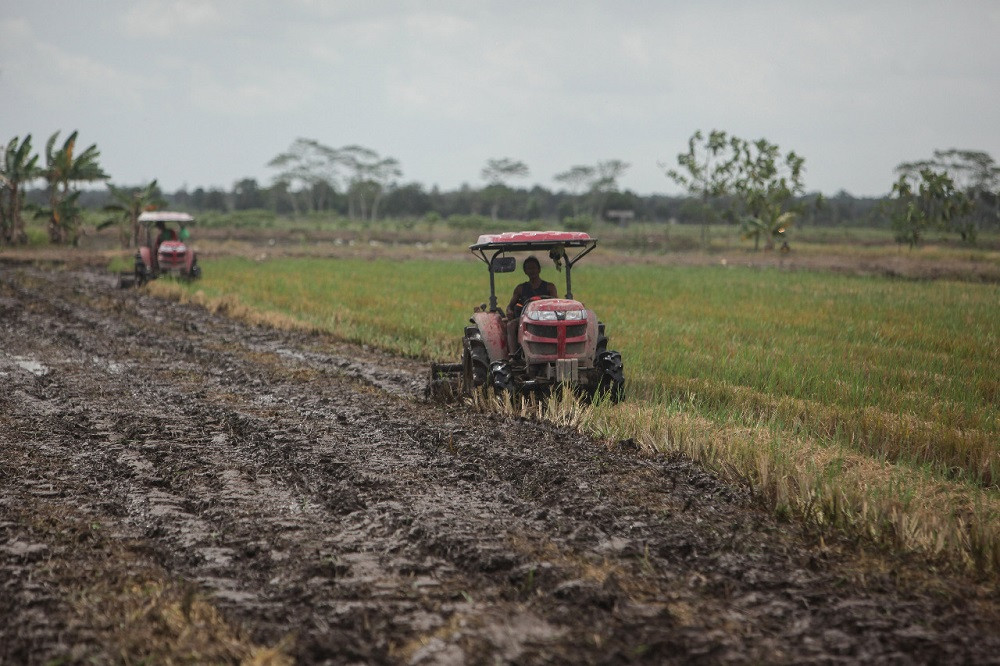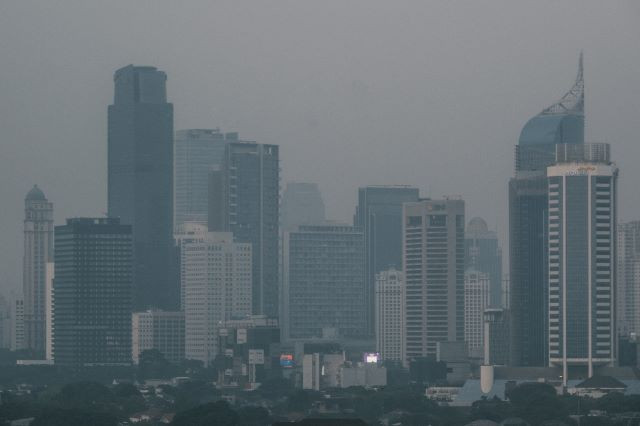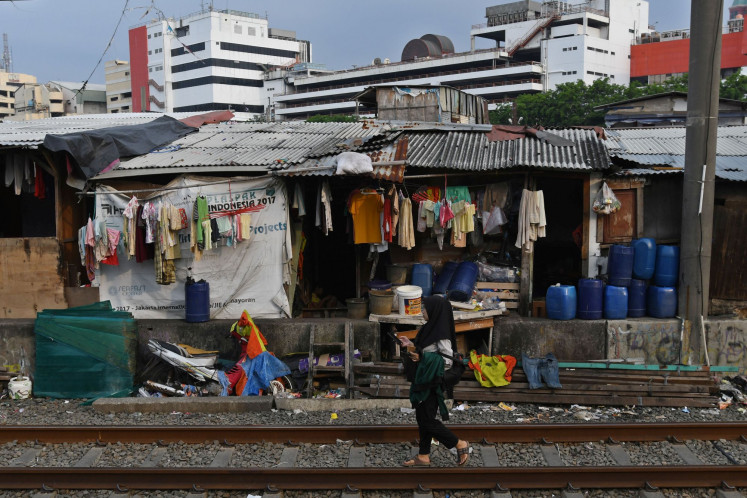Popular Reads
Top Results
Can't find what you're looking for?
View all search resultsPopular Reads
Top Results
Can't find what you're looking for?
View all search resultsExplainer: All you need to know about the govt’s food estates
Change text size
Gift Premium Articles
to Anyone
 Field work: Farmers use tractors to plow rice fields in Belanti village in the Central Kalimantan regency of Pujang Pisau, which the government has designed as a food estate, on Sept. 4. Agriculture is one of the few sectors that has grown amid the COVID-19 pandemic. (Antara/Makna Zaezar)
Field work: Farmers use tractors to plow rice fields in Belanti village in the Central Kalimantan regency of Pujang Pisau, which the government has designed as a food estate, on Sept. 4. Agriculture is one of the few sectors that has grown amid the COVID-19 pandemic. (Antara/Makna Zaezar)
T
he Indonesian government is pinning its hopes for bolstering the nation’s food security on the development of food estates in Central Kalimantan and North Sumatra, despite a similar project having failed in the past and COVID-19 disrupting logistics today.
In Central Kalimantan, President Joko “Jokowi” Widodo’s administration plans to develop around 164,600 hectares of food estates for crops like rice, which is part of its National Strategic Projects for the 2020–2024 period.
In the first phase, which commences this year, the government aims to develop around 30,000 ha, two-thirds of which will be located in Kapuas regency and the rest in Pulang Pisau regency. The Central Kalimantan food estate is estimated to produce 7 tons of rice per ha, Agriculture Minister Syahrul Yasin Limpo said in July.
“Even though it started in September in two regencies, namely Pulang Pisau and Kapuas, we have developed around 4,200 ha as of today. The initial target for September was only 1,921 ha,” Indonesian Army chief of staff Gen. Andika Perkasa said in a statement on Tuesday.
The Army has been helping the ministry with the food estate project in Central Kalimantan. On Tuesday, it inked an agreement with the Agriculture Ministry to partner on agricultural human resource development, among other things.
Meanwhile, in North Sumatera, the government wants to develop a total of 61,000 ha of food estates for horticulture including potato, shallot and garlic, in the regencies of Humbang Hasundutan (Humbahas), Central Tapanuli, North Tapanuli and West Pakpak.
The first phase of development of the North Sumatera food estates will cover 4,000 ha, which has been surveyed by the government from Sept. 20 to 24.
This year, the government said, it would focus on developing a 1,000 ha center for agriculture training and technology in Humbahas, which would serve as a partnership model between farmers and investors.
The Agriculture Ministry will handle 215 ha, and private investors will take 785 ha. According to the Office of the Coordinating Maritime Affairs and Investment Minister, food manufacturers PT Indofood Sukses Makmur, PT Champ Resto Indonesia and PT Calbee Wings Food have expressed interest in the project.
“After we managed the food estate in Humbahas, our next big plan in 2021 will be developing the North Sumatra food estate not only in one regency, but we also want to support other regencies with this program,” Nani Hendiarti, the deputy of Environment and Forestry Management at the Office of the Coordinating Maritime Affairs and Investment Minister, said in a statement on Sept. 25.
Food distribution improvement
The food estates are deemed essential as the COVID-19 crisis has aggravated Indonesia’s food security issues.
In late April, a month after the outbreak in the country, President Joko “Jokowi” Widodo reported that key commodities, such as garlic, sugar, chili and chicken eggs, were in short supply in more than 20 provinces, while rice, a staple food for Indonesians, was lacking in seven provinces.
The World Food Programme’s (WFP) Indonesia office has estimated that the country experienced a 13.2 percent year-on-year decline in rice production to 16.1 million tons in the first half of 2020.
Making matters worse, the dry season looms on the horizon and may impact overall output of the agricultural sector, which employs more than a quarter of the nation’s workforce.
Read also: Pandemic disrupts food distribution across country, minister says
The projects were also aimed at overcoming food distribution issues across the archipelago, land use change, especially in Java, and the increase of the country’s population, said Andriko Noto Susanto, the head of food availability and risks at the Agriculture Ministry’s Food Security Agency (BKP).
“One of our approaches is to develop new food production centers outside the existing ones,” Andriko told The Jakarta Post in a phone interview on Monday.
“So the Central Kalimantan food estate for food crops and the North Sumatra on for horticulture are the measure we take to provide new sources of food there.”
The food estate in North Sumatera is expected to ease the country’s dependency on imports of garlic and other commodities where national production currently fails to meet national demand.
For the May–December period, the Agriculture Ministry estimated Indonesia’s garlic imports would reach around 604,000 tons, mostly from China. It would add to the expected domestic production of 17,600 tons that could not meet the estimated demand of 377,500 tons on the period.
“The one for horticulture in Humbang Hasundutan, North Sumatra, is very important for shallots, garlic and chili,” said Andriko.
“We have a national surplus of chili, but since it is perishable, there will be a problem if the distribution gets disrupted. Developing new production centers is therefore important,” he added.
The logistics disruption caused by restrictions enforced to contain COVID-19 has affected food delivery to many regions in Indonesia, particularly the eastern parts, Minister Syahrul also said earlier in July.
Andriko also said the Central Kalimantan food estate was expected to improve rice distribution, which was presently too heavily concentrated on Java, with some other big production centers in Sumatra and South Sulawesi.
The three main rice producing provinces of East Java, West Java and Central Java produce a combined 37 million tons a year, according to data from the Agriculture Ministry. The three provinces accounted for 67.8 percent of last year’s rice production, according to data from Statistics Indonesia (BPS).
Haunting mistakes of the past
Dwi Andreas Santosa, an agriculture expert from the Bogor Institute of Agriculture (IPB), told the Post that history showed a series of government’s failures in developing food estates in at least the past 25 years.
In the mid-1990s, President Soeharto’s administration sought to develop a similar project called Peatland Development (PLG) comprising around 1.4 million ha in Central Kalimantan. The Jokowi administration will use some of the former PLG land to develop its food estate.
“I was part of the environmental risk analysis team. We had warned [the government] about the possibility of failing. And it totally failed,” Dwi said in a phone interview.
“All of them failed because they ignored the scientific principles in their development,” he added. “To develop a food estate for food crops on a large scale, four important [requirements] must be met.”
They are land and climate suitability, infrastructure for irrigation and transportation, cultivation and technological feasibility, as well as social and economic feasibility, according to Dwi.
Dwi also said the food estate needed to produce at least 4 tons per ha to prevent losses, otherwise farmers would leave the project. Moreover, the government also needed to take into account the necessary labor.
Each hectare will require at least four people, according to Dwi’s estimate.
The Agriculture Ministry is providing production tools worth Rp 379 billion (US$25.4 million). The ministry has offered 98 four-wheel tractors, 150 two-wheel tractors and 35 rice transplanters.
The Center for Indonesian Policy Studies (CIPS) lauded the government’s efforts to boost food production, but did not necessarily support the food estate program, it said in a statement provided to the Post on Thursday. The CIPS is of the view that the program, which involves peatland development, could have a negative impact on the local environment and the peat forest ecosystem.
“[The program] could result in losses for farmers and certainly for the government, since it is not spending the budget properly,” CIPS researcher Galuh Octania said by text message on Sept. 26.
The government should instead focus on policies to attract greater investment and encourage agricultural innovation to support domestic production, the think tank said in its statement.
Editor's note: This article has been revised to correctly state Center for Indonesian Policy Studies (CIPS) researcher Galuh Octania and CIPS statements.









